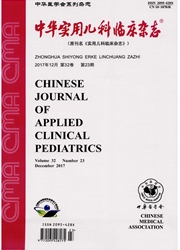

 中文摘要:
中文摘要:
Objective To explore the role of glucocorticoid (GC) receptor (GR) in rapamycin's reversion of GC resistance in humanGC-resistant T-acute lymphoblastic leukemia (ALL) CEM-C1 cells. Methods CEM-C1 cells were cultured in vitro and treated with rapamycin at different concentrations with or without 1 μmol/L dexamethasone (Dex). 3-(4, 5-dimethylthiazol-2-yl)-2, 5-diphenyltetrazolium bromide (MTT) test was performed to assess cell proliferation. The cell cycle and cell apoptosis were analyzed by flow cytometry. The expression of GRα mRNA was determined by real-time quantitative RT-PCR. The expression of GR, p-70S6K, Mcl-1, and Bim proteins was detected by Western blot. Results When incubated with rapamycin at different concentrations, CEM-C1 cells showed significant growth inhibition in a time- and concentration-dependent manner. The growth inhibition was synergistically increased when CEM-C1 cells were treated with rapamycin plus 1 μmol/L Dex. CEM-C1 cells treated with rapamycin alone showed no apparent apoptosis, and were arrested at G0/G1 phase. After the treatment with Dex plus rapamycin, CEM-C1 cells demonstrated apparent apoptosis and increased the cell cycle arrested at G0/G1 phase. Rapamycin combined with Dex up-regulated GRα, phosphorylated GR(p-GR), and pro-apoptotic protein Bim-EL in CEM-C1 cells, but inhibited the expression of p-p70S6K, a downstream target protein ofmTOR (mammalian target of rapamycin). Conclusion After the treatment with rapamycin plus Dex, Dex resistant CEM-C1 cells induce growth inhibition and apoptosis. The underlying mechanism may involve inhibition of the mTOR signaling pathway and also be associated with up-regulation of GR expression and activation of GC-GR signaling pathway.
 英文摘要:
英文摘要:
Objective To explore the role of glucocorticoid (GC) receptor (GR) in rapamycin's reversion of GC resistance in humanGC-resistant T-acute lymphoblastic leukemia (ALL) CEM-C1 cells. Methods CEM-C1 cells were cultured in vitro and treated with rapamycin at different concentrations with or without 1 μmol/L dexamethasone (Dex). 3-(4, 5-dimethylthiazol-2-yl)-2, 5-diphenyltetrazolium bromide (MTT) test was performed to assess cell proliferation. The cell cycle and cell apoptosis were analyzed by flow cytometry. The expression of GRα mRNA was determined by real-time quantitative RT-PCR. The expression of GR, p-70S6K, Mcl-1, and Bim proteins was detected by Western blot. Results When incubated with rapamycin at different concentrations, CEM-C1 cells showed significant growth inhibition in a time- and concentration-dependent manner. The growth inhibition was synergistically increased when CEM-C1 cells were treated with rapamycin plus 1 μmol/L Dex. CEM-C1 cells treated with rapamycin alone showed no apparent apoptosis, and were arrested at G0/G1 phase. After the treatment with Dex plus rapamycin, CEM-C1 cells demonstrated apparent apoptosis and increased the cell cycle arrested at G0/G1 phase. Rapamycin combined with Dex up-regulated GRα, phosphorylated GR(p-GR), and pro-apoptotic protein Bim-EL in CEM-C1 cells, but inhibited the expression of p-p70S6K, a downstream target protein ofmTOR (mammalian target of rapamycin). Conclusion After the treatment with rapamycin plus Dex, Dex resistant CEM-C1 cells induce growth inhibition and apoptosis. The underlying mechanism may involve inhibition of the mTOR signaling pathway and also be associated with up-regulation of GR expression and activation of GC-GR signaling pathway.
 同期刊论文项目
同期刊论文项目
 同项目期刊论文
同项目期刊论文
 期刊信息
期刊信息
